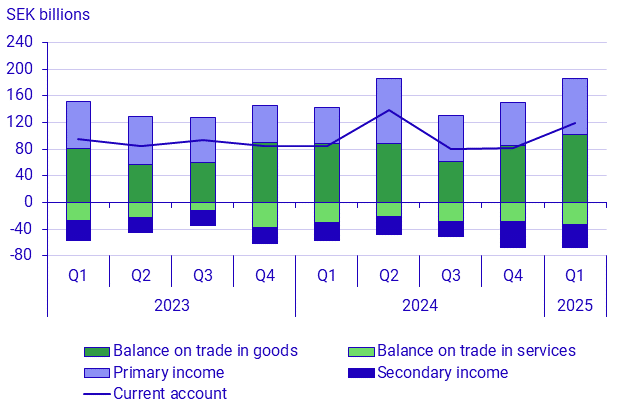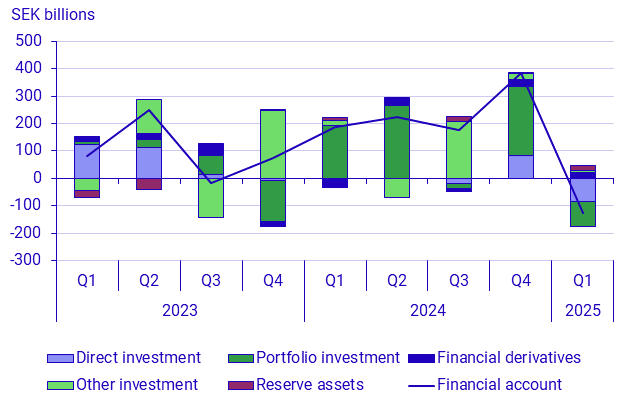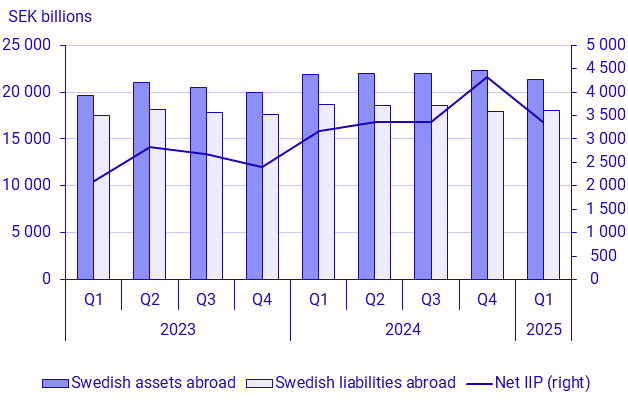Balance of payments, 1st quarter 2025
Sweden's current account surplus strengthens as a result of higher primary income
Statistical news from Statistics Sweden 2025-06-05 8.00
During the first quarter of 2025, the current account surplus amounts to SEK 119.3 billion, an increase of SEK 34.3 billion compared to the first quarter of 2024. The increase is driven primarily by a decrease in primary income on the import side of SEK 29.5 billion, but also due to an increase in the trade balance.
“The current account surplus increases as a result of a net increase in primary income, which is mainly due to a decrease in capital returns on the import side” says Viktor Penna, economist in the Balance of Payments section.
The value of Sweden’s total net assets against the rest of the world, as shown in the international investment position, amounts to SEK 3 352.2 billion at the end of the quarter. A decrease of SEK 975.2 billion from the previous quarter can be explained by value decrease in foreign portfolio investments. The financial balance shows net borrowing to foreign countries of SEK 128.6 billion during the first quarter of 2025. Foreign investments in Sweden are increasing, as are Swedish investments abroad.
What is the Balance of Payments?
The balance of payments is a statement of all Swedish transactions with the rest of the world. It presents exports and imports of goods and services and includes a description of changes in financial assets and liabilities with the rest of the world. The balance of payments consists of the current account, the financial account, and the capital account. The component parts of the Balance of Payments and related terms are explained under Definitions and explanations, at the end of this item of statistical news.
Current account surplus as share of Sweden’s GDP
Sweden’s current account as a percentage of GDP amounted to 6.5 percent. For the fourth quarter of 2024 the share amounted to 6.0 percent. The share is calculated as an average over the four last quarters.

Comparisons between periods in the current account are made using the corresponding quarter the previous year.
Export of goods are increasing as is import of goods
The trade balance showed a surplus of SEK 101.7 billion during the first quarter of 2025, an increase by SEK 13.5 billion from the first quarter of 2024. Exports of goods amounted to SEK 593.2 billion, an increase by SEK 22.4 billion compared with the corresponding quarter a year ago. Imports of goods amounted to SEK 491.5 billion, an increase by SEK 8.9 billion in a corresponding comparison.
Merchanting, which is included in the trade balance, decreases by SEK 5.1 billion compared to the first quarter of 2024. The surplus in the first quarter of 2025 amounts to SEK 52.5 billion.
The balance of traded services noted a deficit of SEK 32.3 billion, compared with the deficit of SEK 30.4 billion in the first quarter of 2024. Import of services amounted to SEK 329.7 billion, an increase by SEK 19.4 billion compared with the first quarter of 2024. At the same time, export of services shows an increase by SEK 17.5 billion and amounted to SEK 297.4 billion, in a corresponding comparison.
A positive contribution from primary income
Primary income, which consists mainly of compensation of employees and investment income, presented a surplus of SEK 84.5 billion in the first quarter 2025. This is an increase by SEK 30.7 billion compared with the corresponding quarter a year ago. The surplus in investment income went from SEK 50.4 billion in the first quarter of 2024 to SEK 79.1 billion in the actual quarter.
Portfolio investment contributed a surplus of SEK 27.6 billion to investment income, up by SEK 25.0 billion compared with the corresponding quarter a year ago. Investment income on other investment contributed with a deficit of SEK 12.6 billion, up by SEK 3.8 billion in the same comparison.
The deficit in secondary income increases
Secondary income, which includes current international cooperation and contributions to the EU, presented a deficit of SEK 34.6 billion. The deficit increased by SEK 7.9 billion compared with the corresponding quarter a year ago.
Net borrowing in the financial account
The financial account noted net borrowing amounting to SEK 128.6 billion in the first quarter of 2025. Net lending and net borrowing refer to the overall balance in the financial account.
During the first quarter financial derivatives, other investments, and reserve assets shows net lending.

Direct investments increased both in Sweden and abroad
Net borrowing in direct investments amounted to SEK 85.6 billion during the quarter. Foreign direct investments in Sweden increased by SEK 126.3 billion, while Swedish direct investments abroad increased by SEK 40.7 billion.
Portfolio investment decreased abroad and increased in Sweden
Net borrowing in portfolio investment amounted to SEK 90.4 billion during the quarter. Foreign investors increased their portfolio investments in Sweden by SEK 75.5 billion and Swedish investors decreased their portfolio investments abroad by SEK 14.6 billion.
Other investment increased both abroad and in Sweden
Net lending in other investment corresponded to SEK 6.0 billion. Swedish other investment abroad increased by SEK 425.2 billion, while foreign other investment in Sweden increased by SEK 419.2 billion.
Financial derivatives and reserve assets
Net lending in financial derivatives amounted to SEK 21.2 billion. Reserve assets noted increased net lending corresponding to SEK 20.2 billion.
A decrease in net assets abroad
Sweden's net external asset position amounted to SEK 3 352.2 billion, at the end of the first quarter 2025, showing an decrease of SEK 975.2 billion compared to the previous quarter, when net assets amounted to SEK 4 327.4 billion.

Swedish foreign assets decreases while liabilities increase
Swedish foreign assets amounted to SEK 21 334.9 billion in the first quarter, which corresponds to a decrease of SEK 932.3 billion compared to the previous quarter. At the same time, Swedish liabilities to foreign entities increased to SEK 17 982.7 billion in the first quarter, an increase of SEK 42.9 billion.
Swedish portfolio investments abroad are decreasing, as is foreign portfolio holdings in Sweden. Swedish investments in financial derivatives abroad are showing a decrease, which is also seen in foreign investments in Swedish derivatives. Other investments abroad are increasing and foreign other investments in Sweden are increasing. Swedish direct investments abroad are decreasing, while foreign direct investments in Sweden show an increase. Sweden's foreign exchange reserves decreased during the period.
Differences between the Balance of Payments and the National Accounts
There are differences between estimations in the Balance of Payments and the National Accounts. There has been a focus on coordinating sources and methods in the calculation of the current account in order to increase the agreement between the statistics.
The results of this work were implemented in connection with the publication of the first quarter of 2020 for both the Balance of Payments and the National Accounts calculations of GDP in the real sector accounts. This has led to revisions of the time series.
The coordination of the Balance of Payments and National Accounts means that estimates of primary statistics, such as foreign trade in services, may differ from values published in the respective surveys.
Efforts to improve agreement in the current account will continue going forward. Work has also begun on increasing agreement between the financial parts of the Balance of Payments and the financial accounts.
Find more information here: samordning-av-bytesbalansen.pdf (Swedish)
Revisions
The balance of payments follows a predetermined revision policy, see section 2.3 in the Quality Declaration 2025. Quality Declaration: Balance of Payments and International Investment Position, 2024 (scb.se).
The time series for the balance of payments and the international investment position has been revised from the first quarter of 2021.
Tables related to revisions by account item for the balance of payments and the international investment position reflect the revisions made in connection with the publication of the first quarter of 2025.
The time series for balance of payments and international investment positions and has been revised from the first quarter of 2021. As a part of the work in coordinating statistics between balance of payments and the national accounts, some revisions have been included due to the national accounts continued work in revising data sources, methods and computational models. The revisions affect trade in goods and services. More information on the national account revisions from May 2024 and minor revision from May 2025 can be found in Revision of the time series
in May 2025 (pdf)
Definitions and explanations
The current account and the financial account record real and financial transactions with regard to the rest of the world. Only transactions are recorded; value changes, such as exchange rate fluctuations are excluded.
The current account shows the trade in goods (foreign trade in goods), the trade in services (foreign trade in services), primary income (compensation to employees, investment income, other primary income), and secondary income (current transfers). Surplus and deficit in the current account refer to the difference between Sweden’s exports and Sweden’s imports. A positive outcome results in a surplus, while a negative outcome results in a deficit. Comparisons between periods in the current account are always made using the corresponding quarter the previous year, due to seasonal patterns in data.
The financial account consists of direct investment, portfolio investment, financial derivatives, other investment, and reserve assets. Sweden can acquire and dispose of financial assets abroad. All transactions during the quarter concerning external assets show Sweden’s change in net external assets. Sweden can also borrow and repay financial external liabilities. All transactions during the quarter concerning external liabilities show Sweden’s change in net external liabilities. The difference between Sweden’s change in net external assets and Sweden’s change in net external liabilities can be positive or negative, and shows net lending and net borrowing, respectively.
The capital account records Sweden’s capital transfers and transfers of non-financial assets with regard to the rest of the world. Compared with other parts of the balance of payments, amounts in the capital account are usually small.
The difference between Sweden’s financial external assets and liabilities position is the net of Sweden’s international investment position, which can be positive or negative.
An increase or decrease in assets describes Sweden’s external assets. An increase or decrease in liabilities describes Sweden’s external liabilities.
Merchanting, which forms a part of the trade in goods, refers to triangular trade in which goods are purchased and sold abroad without the good crossing a Swedish border.
Statistical Database
More information is available in the Statistical Database
Feel free to use the facts from this statistical news but remember to state Source: Statistics Sweden.
